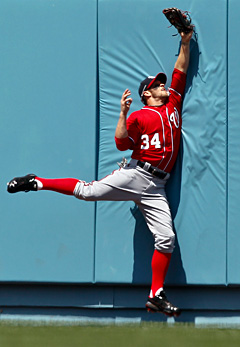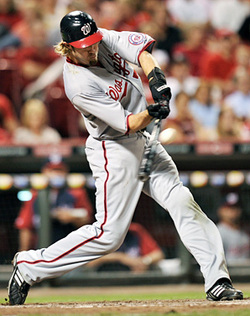
An offseason in which the Nationals' major goal was to find a center fielder and leadoff hitter, the Nats killed two birds with one stone by acquiring outfielder Denard Span. On Thursday, the Minnesota Twins reached an agreement to send Span to the Washington Nationals for minor league pitcher Alex Meyer. Span is signed through 2014 and has a $9 million club option for 2015.
Denard Span will be moving from a rebuilding Minnesota Twins ball club to a Washington Nationals team who is expected to be amongst the best in the game again in 2013. Span absolutely strengthens this team as he will provide some solid production from the outfield. Expected to slot in as Washington’s leadoff hitter, Span has hit .284/.357/.389 throughout his 5 year career. In this aspect, Span should certainly be an upgrade, as National leadoff hitters only hit a collective .276/.325/.419 for 2012. Span is also coming off a successful 2012 season in which he batted .283/.342/.395 and had a career high in WAR (4.8). In addition, Span provides above average speed as he stole 17 bases in 2012 and has shown the ability to steal 20-25 bags in the past. To complete his all around package, Span is a terrific defensive center fielder who had 20 defensive runs saved and the highest dWAR (2.4) among outfielders in 2012. Span is a perfect match for a team in need of a center fielder and his deal is short enough that it should not block minor leaguer Brian Goodwin when he is ready.
Denard Span will be moving from a rebuilding Minnesota Twins ball club to a Washington Nationals team who is expected to be amongst the best in the game again in 2013. Span absolutely strengthens this team as he will provide some solid production from the outfield. Expected to slot in as Washington’s leadoff hitter, Span has hit .284/.357/.389 throughout his 5 year career. In this aspect, Span should certainly be an upgrade, as National leadoff hitters only hit a collective .276/.325/.419 for 2012. Span is also coming off a successful 2012 season in which he batted .283/.342/.395 and had a career high in WAR (4.8). In addition, Span provides above average speed as he stole 17 bases in 2012 and has shown the ability to steal 20-25 bags in the past. To complete his all around package, Span is a terrific defensive center fielder who had 20 defensive runs saved and the highest dWAR (2.4) among outfielders in 2012. Span is a perfect match for a team in need of a center fielder and his deal is short enough that it should not block minor leaguer Brian Goodwin when he is ready.
-Nick Rabasco
Heading to the Twin Cities (or at least AA affiliate New Britain, CT) is 6'9", 220 lb man-child, Alex Meyer. Meyer finished the season in High A Potomac with a 2.86 ERA, 129 innings, 139 strikeouts, and a superb 6.7 H/9. Meyer's repertoire includes a high 90's fastball and a plus, wipeout slider that sits in the low-mid 80's. His changeup remains a work in progress. In addition to his changeup questions, his height has given him problems repeating his delivery. An inability to control and repeat one's delivery leads to ineffective and erratic command. And an inability to command one's stuff often results in being delegated to relief. If Meyer were to go in relief, his command issues could be minimized while his stuff could play up in shorter durations. Throughout the year, Meyer battled bouts of wildness, but showed improved command of his pitches (3.1 BB/9) compared to his time at the University of Kentucky. In reality, if Meyer can maintain this ability to throw strikes, there is a good bet he can remain a starter, a position in which more value lies (see Chapman piece on the value of innings). Minnesota acquired an uber-talented arm with front of the rotation potential. However, for Minnesota to claim victory on this trade, it hinges on Meyer's ability to start at the big league level. For additional information on Alex Meyer, check out the scouting report released during our prospect ranking countdown.
Heading to the Twin Cities (or at least AA affiliate New Britain, CT) is 6'9", 220 lb man-child, Alex Meyer. Meyer finished the season in High A Potomac with a 2.86 ERA, 129 innings, 139 strikeouts, and a superb 6.7 H/9. Meyer's repertoire includes a high 90's fastball and a plus, wipeout slider that sits in the low-mid 80's. His changeup remains a work in progress. In addition to his changeup questions, his height has given him problems repeating his delivery. An inability to control and repeat one's delivery leads to ineffective and erratic command. And an inability to command one's stuff often results in being delegated to relief. If Meyer were to go in relief, his command issues could be minimized while his stuff could play up in shorter durations. Throughout the year, Meyer battled bouts of wildness, but showed improved command of his pitches (3.1 BB/9) compared to his time at the University of Kentucky. In reality, if Meyer can maintain this ability to throw strikes, there is a good bet he can remain a starter, a position in which more value lies (see Chapman piece on the value of innings). Minnesota acquired an uber-talented arm with front of the rotation potential. However, for Minnesota to claim victory on this trade, it hinges on Meyer's ability to start at the big league level. For additional information on Alex Meyer, check out the scouting report released during our prospect ranking countdown.
-Aidan Flynn
First Impressions
Winners: Nationals, Twins;
First Impressions
Winners: Nationals, Twins;
Both teams acquired players that will suit their short term and long term needs. The Nationals further augmented a team that won the most games in the junior circuit, and Span's extremely reasonable contract should give the team financial flexibility to make additional moves (Adam LaRoche?).
The Twins are clearly a team in rebuild mode and improved the farm system with one of the most talented arms in the minors. If Meyer would have to transition to reliever, this trade would swing in favor of Washington, but I have enough confidence in Meyer's ability that this trade should work out well for both parties involved.
The Twins are clearly a team in rebuild mode and improved the farm system with one of the most talented arms in the minors. If Meyer would have to transition to reliever, this trade would swing in favor of Washington, but I have enough confidence in Meyer's ability that this trade should work out well for both parties involved.


 RSS Feed
RSS Feed